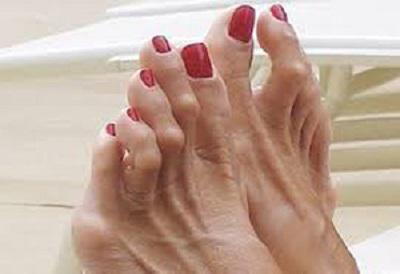
Hammertoes are one of the more common foot deformities that women suffer from. Women are more likely to get hammertoes than men and account for nearly 80 percent of the hammertoe cases I treat. Many women with this condition have been suffering in pain and reluctantly forced to end the physical activities they once loved. Any activity that required a bit more walking or standing became difficult without adding another layer of padding to their toes or shoes. Playing tennis or running was even more challenging, and many “just called it quits.” Hammertoes can also cause skin lesions, callosities, ulcers, nail deformities, and change in gait (walking). For many women, hammertoes are a source of embarrassment and frustration because toe deformity alters their appearance and restricts their choice of shoe wear.
When I ask my patients why it took them so long to seek treatment, the overriding response is that they were too busy to take time off for surgery. Many of them are scared to death of surgery because they have heard the horror stories of having wires stick out of their toes
There is a variety of conventional and operative treatment options for hammertoes. New medical advancements are constantly becoming available. Here is some useful information that will help you to understand your condition and treatment options.
Non-Surgical Treatments Non-surgical treatments cannot correct a hammertoe deformity but in most cases, they should be tried before considering surgery. The goal of non-surgical treatments is to prevent the progression from advancing and to eliminate pain. Here are some tips:
- Wear comfortable shoes that have a large box around the hammertoes and low heels
- Visit a shoe repair shop to have your shoes spot-stretched
- Trim or file down calluses and corns with a pumice stone following a bath or shower
- Try over-the counter pads, toe sleeves, toe cushions, splints, or shoe inserts
- Consult with your doctor about custom orthotics and self-help stretching exercises
When to Consider Surgery
Surgery becomes an option if the conservative treatments do not improve your symptoms or alleviate pain. It is a last resort measure to correct the deformity and relieve pain. Unfortunately, the outcome cannot be predicted. There is no guarantee that your toes will completely return to their normal position after surgery; and joint problems may return. If the deformity is the result of a nervous system problem or a condition that affects your blood vessels, surgery may not even be an option.
Surgical Treatments
There is no single surgical procedure that is best for everyone because each patient is different. After a thorough assessment, your surgeon will determine if surgery is the best option. Multiple surgical procedures are available. Your surgeon may mix and match procedures to tailor the best treatment for you.
Usually surgery is done on an outpatient basis with a local anesthetic and you are allowed to go home the same day. In most cases you can walk after surgery and you are not put in a cast; however, you have to follow strict guidelines during healing to avoid complications.
Some of the more common surgical treatments include:
- Removal of part of the toe bones in the joint so the toe can be straightened (Resection)
- Re-routing (Tendon Transfer) or Cutting (Tendon Lengthening or Capsule Release) to improve alignment and ease joint tension
- Shortening the long bone to provide more space for the toe (Metatarsal Shortening)
- Removing part of the joint to let the toe bones grow together to minimize motion and pain (Arthrodesis)
Several procedures require the implantation of orthopedic devices to fix the deformity and to neutralize the soft tissue imbalances that contribute to the deformity. Your surgeon will tell you about these options.
Recovery
Recovery depends on the type of surgery performed and how well you heal. In minor procedures (tendon release or lengthening) surgery is simple and quick, and recovery time is minimal. In moderate cases (use of permanent implants), surgery is more complex and recovery is 1–2 months. In more advanced procedures (use of wire pins and other hardware or multiple procedures) recovery is longer. Wire pins are removed in 6 weeks and full recovery is in 4–6 months. In all cases, patients who have a sedentary job can return to work quicker than patients whose job requires standing, walking, or physical activity.
Success Rates
The estimated success rate for hammertoe surgery is high, around 85–90 percent; however, it is difficult to predict the results of hammertoe surgery because there is such a wide variety of deformities and surgical variables. Success largely depends on the severity of the deformity, type of surgery, and surgeon’s skill and experience. In some cases, the outcome may be worse than the pre-operative condition. Consult with your surgeon about the risks prior to making a decision.
Don’t let hammertoes cramp your style. There are plenty of non-surgical and surgical options available to address your condition and relieve pain. If you are interested in seeking a board certified surgeon for information about hammertoes and treatment options, call Dr. John Sigle at 217-787-2700 for an appointment. Also visit the Foot& Ankle Center of Illinois website library at myfootandanklecenter.com for additional information on toe implants.
